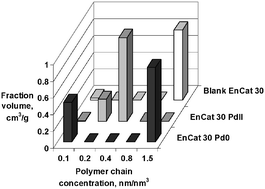Cross-linked polyvinyl polymersversus polyureas as designed supports for catalytically active M0 nanoclusters
Part III.† Nanometer scale structure of the cross-linked polyurea support EnCat 30 and of the PdII/EnCat 30 and Pd0/EnCat 30NP catalysts‡
Abstract
The cross-linked polyurea support EnCat 30, its related macromolecular complex PdII/EnCat 30 and its related Pd0/EnCat 30NP nanocomposite are thoroughly investigated with

- This article is part of the themed collection: Celebrating the centenary of the Italian Chemical Society

 Please wait while we load your content...
Please wait while we load your content...